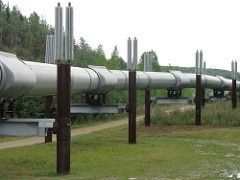Mar 22 2019
Oil pipelines, truckloads of coal, and electric wires are the normal images that come to one’s mind while considering meeting the increasing energy needs across the globe.
 Alaskan pipeline. (Image credit: Arthur D. Chapman and Audrey Bendus)
Alaskan pipeline. (Image credit: Arthur D. Chapman and Audrey Bendus)
However, research at Michigan State University (MSU) has shown that more energy, within the goods, goes nearly unrecognized and leaves its environmental impression home.
In the study published in Applied Energy, scientists at MSU investigated the flow of virtual energy in China—the energy used to manufacture products and goods at one site and be transported elsewhere. The researchers discovered that virtual energy flowed from less-populated, energy-deficient areas in the western regions of China to flourishing cities in the energy-rich east.
Indeed, the shipping of the virtual energy from west to east was more when compared to the physical energy that flows through China’s massive infrastructure investment, the West-To-East Electricity Transmission Project. As China is a dynamic model of energy use, it outperformed the United States. In 2013, about 22% of universal energy use was in China.
Conserving energy and managing its accompanying environmental impacts are a growing concern across the world, and it is crucial to take a holistic look at all the ways energy is used and moved. Only when we understand the full picture of who is producing energy and who is consuming it in all its forms can we make effective policy decisions.
Jianguo “Jack” Liu, Rachel Carson Chair in Sustainability, Center for Systems Integration and Sustainability (CSIS), MSU
Virtual energy was deemed vital to defuse local energy crises as the products, as well as virtual energy, are traded from one place to another, which means that the trading area can prevent the spending of the energy to manufacture the imported commodities. The article “Shift in a National Virtual Energy Network” shows that the economic and energy demands of a region with or without energy are met by accepting that energy is closely wound around commercial growth and demand.
First, the scientists have to focus on the energy use after the 2008 world economic crisis, perceiving how economic desperation could have a great, not always evident, effect on energy—and the pollution and environmental deterioration that can result from its use.
China, like a lot of places across the globe, has an uneven distribution of energy resources, and China also is developing quickly. We wanted to understand the true paths of energy use when economic growth kicks into gear after a financial crisis. Eventually, all the costs of energy use, including environmental damage and pollution, have to be accounted for, and currently policies focus primarily on physical energy, not virtual energy.
Zhenci Xu, Study First Author, MSU.
Zhenci Xu is also an MSU-CSIS PhD student.
The scientists discovered a constant flow of total virtual energy from the energy-deficient to energy-rich countrysides increased from 43.2% in 2007 to 47.5% in 2012. After the framework of meta-coupling (interactions between socioeconomic and environmental factors within and between nearer and distant places), they also found that trade took place between distant provinces after the financial crisis—trade that accompanied environmental footprint of energy.
The researchers show that these kinds of analyses are required all over the world to direct policies that hold the areas that shift their consumption of energy to duly contribute to justify the actual energy costs.
Apart from Liu and Xu, this work was performed by Paul McCord and Mimi Gong of MSU-CSIS and Di Zhang of China’s Hunan University.
The study was financially supported by the National Science Foundation, MSU, Michigan AgBioResearch, and China Scholarship Council.